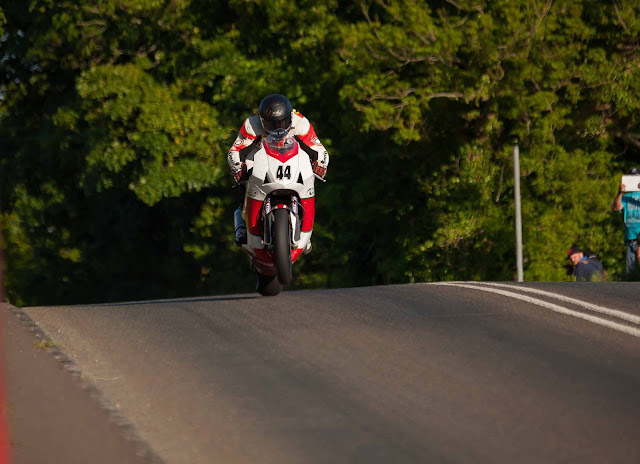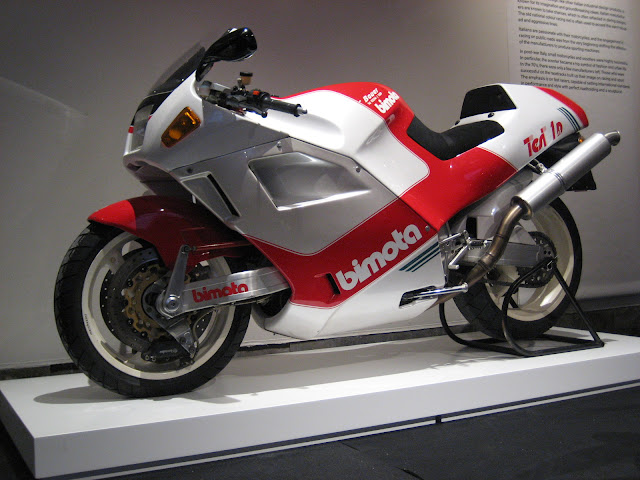Bimota SB2
The SB2’s stunning styling and advanced chassis technology resulted in a bike that could almost have been built more than 20 years after its actual debut in 1977. The Bimota’s swooping one-piece tank cover and seat unit was a self-supporting structure made from fibreglass and aluminium. Other advanced features included cast wheels, drilled discs and rising-rate monoshock suspension.
When Bimota, a small company from Rimini in north-eastern Italy, released its first streetbike in 1977, motorcycle design took a sudden leap forward. The SB2. powered by the 748cc four-cylinder engine from Suzuki’s recently released GS750 four, was visually striking, brilliantly engineered and uniquely single-minded. Its bold, fully-faired styling was matched by a chassis that combined a technically advanced frame with state-of-the-art cycle parts.
Bimota, whose co-founder and genius designer Massimo Tamburini would later create such bikes as the Ducati 916 and MV Agusta F4, had already established an unmatched reputation in grand prix racing, having produced the chassis that Johnny Cecotto and Walter Villa had used to win 250 and 350cc world championships in 1975 and ’76. With the SB2, Tamburini brought to the street some of that racing technology, including the first monoshock rear suspension system seen on a production motorcycle.
The SB2 frame was made from tubular steel, but was a much more complex and advanced structure than the twin-downtube affairs of most mass-produced superbikes. Fabricated from chrome-molybdenum tube of varying diameters, it featured a heavily braced steering head area, used the engine as a stressed member, and incorporated conical couplings that enabled the front and rear frame sections to be split, facilitating engine removal. Steering geometry could be adjusted by rotating eccentric bearings in the triple clamps.
The Bimota also held its fork legs at a different angle to the steering head (28 degrees the forks, 24 the head), to reduce the change in trail under braking. The vertically mounted rear De Carbon unit was operated by a rising-rate rocker arm. The box-section steel swingarm curved outwards to pivot concentric with the final drive sprocket, maintaining constant chain tension. Chassis details such as triple clamps and foot controls were machined from aircraft-grade aluminium alloy.
No expense spared
Tamburini also spared no expense in specifying the cycle parts, which included 35mm Ceriani forks with internals modified by Bimota, five-spoke alloy wheels in 18-inch diameters, and drilled Brembo discs gripped by twin-piston calipers. Even the dramatically shaped tank/seat unit was highly- advanced. Made from fibreglass lined with aluminium, it was self-supporting, so required no rear subframe and was a predecessor of modern carbon-fibre structures of similar design. The SB2 weighed 440lb (200kg) without fuel - 60lb (27kg) less than the standard GS750.
The SB2 held Suzuki’s dohc 16-valve aircooled engine 25mm higher than in the standard bike for improved ground clearance. Bimota’s basic SB2 model used a standard engine, but many owners opted for a tuning package. This typically combined Mikuni smoothbore carbs, 850cc big- bore kit, Yoshimura cams and high-compression pistons, plus a free-breathing four-into-one exhaust system. Peak output would typically be about 85bhp, up from the standard 68bhp.
That combined with the Bimota’s sleek shape and light weight to give storming acceleration to a top speed of around I30mph (2l0km/h), but it was the bike’s handling that really stood out. The SB2 was compact, firmly suspended and highly manoeuvrable. Yet it was also remarkably stable and controllable in tight turns and sweeping curves alike, thanks to its blend of race-developed geometry, chassis rigidity and suspension control. It also had powerful brakes, abundant ground clearance and excellent roadholding.
For all-round performance and cornering ability the SB2 was streets ahead of mass-produced superbike in 1977. Inevitaly it was hugely expensive, and in many markets cost three times as much as the standard GS750. Only 70 units were built, and Bimota was forced to compromise slightly with subsequent machines. All of which merely adds to the reputation of the SB2: the finest, most advanced superbike of its era.
Specification Bimota SB2 (1977)
- Engine Air-cooled dohc eight-valve four (Suzuki GS750)
- Capacity 749cc (65 x 56.4mm)
- Maximum power 68bhp @ 8500rpm (standard engine)
- Transmission Five-speed, chain final drive
- Frame Tubular steel space-frame
- Suspension Telescopic front; monoshock rear
- Brakes Twin discs front; disc rear
- Weight 440lb (200kg)




















0 comments: